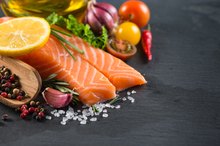What does fact checked mean?
At Healthfully, we strive to deliver objective content that is accurate and up-to-date. Our team periodically reviews articles in order to ensure content quality. The sources cited below consist of evidence from peer-reviewed journals, prominent medical organizations, academic associations, and government data.
The information contained on this site is for informational purposes only, and should not be used as a substitute for the advice of a professional health care provider. Please check with the appropriate physician regarding health questions and concerns. Although we strive to deliver accurate and up-to-date information, no guarantee to that effect is made.
Comparison of Omega 3 in Herring and Salmon
Omega 3 is one of two essential fatty acids necessary to the human body. Called essential because it cannot be produced by the body, omega 3 must be obtained from the diet. Fish typically contain high levels of omega 3m but not all fish are created equal. Herring and salmon are two popular fish choices that provide good amounts of omega 3.
The Importance of Omega 3
The essential fatty acids, omega 3 and omega 6, are very important to the human body. They provide the raw materials for the production of hormone-like substances that are involved in the regulation of many processes in the body, including blood pressure, blood lipids, the immune response, and the inflammation response to injury, infection, and stress. Although severe deficiencies are rare, the typical American diet is low in omega 3 and high in omega 6.
Types
Fish Containing Highest Levels of EPA & DHA
Learn More
The omega 3 fatty acid family can further be divided into three types. The primary form is linolenic acid, which is found in canola oil, soybeans, flaxseed, and walnuts. The other two omega 3 fatty acids are EPA (eicosapentaenoic acid) and DHA (docosahexaenoic acid). Found primarily in fish and shellfish, EPA and DHA can also be made in small amounts by the human body from linolenic acid. Since this is an inefficient conversion, it is recommended to consume EPA and DHA directly 1.
- The omega 3 fatty acid family can further be divided into three types.
- The primary form is linolenic acid, which is found in canola oil, soybeans, flaxseed, and walnuts.
Recommendations
No official intake recommendations exist for the omega 3 fats, but adequate intake levels have been established. Males should consume 1.6 grams per day, and females should consume 1.1 grams per day. Even one fish meal per week has been associated with a reduced risk of heart disease, but experts recommend consuming fish two to three times per week, totaling at least 10 ounces of fish, as well as small amounts of vegetable oils, for optimal health benefits.
- No official intake recommendations exist for the omega 3 fats, but adequate intake levels have been established.
- Even one fish meal per week has been associated with a reduced risk of heart disease, but experts recommend consuming fish two to three times per week, totaling at least 10 ounces of fish, as well as small amounts of vegetable oils, for optimal health benefits.
Sources
Is There Limit to How Much Tuna Fish and Sardines You Can Eat?
Learn More
Coldwater fish provide the highest amounts of the omega 3 fatty acids EPA and DHA. The amount and type of omega 3 fat varies from fish to fish, so it is recommended to consume a variety of fishes. Salmon and herring contain some of the highest levels of omega 3. A four-ounce serving of Atlantic salmon contains 2.1 grams of omega 3, whereas a same-size serving of Pacific herring contains 2.4 grams of omega 3.
- Coldwater fish provide the highest amounts of the omega 3 fatty acids EPA and DHA.
Shopping Tips
When shopping for fish, choose wild over farm raised whenever possible, especially when purchasing salmon. Studies have shown that wild fish have higher levels of omega 3 and are generally more environmentally friendly. To choose the freshest fish possible, look for rich red gills, shiny even-colored skin, and bright, clear eyes. Plan on cooking the fish the day of purchase if possible. If not, fish will stay fresh in the refrigerator, on ice, for a few days.
- When shopping for fish, choose wild over farm raised whenever possible, especially when purchasing salmon.
- To choose the freshest fish possible, look for rich red gills, shiny even-colored skin, and bright, clear eyes.
Related Articles
References
- "Nutrition Concepts and Controversies"; Frances Sizer and Eleanor Whitney; 2000
- Jouris, K. B., McDaniel, J. L., & Weiss, E. P. (2011). The effect of omega-3 fatty acid supplementation on the inflammatory response to eccentric strength exercise. Journal of Sports Science & Medicine, 10(3), 432.
- Tartibian, B., Maleki, B. H., & Abbasi, A. (2009). The effects of ingestion of omega-3 fatty acids on perceived pain and external symptoms of delayed onset muscle soreness in untrained men. Clinical Journal of Sport Medicine, 19(2), 115-119.
- Parra, D., Ramel, A., Bandarra, N., Kiely, M., MartÃnez, J. A., & Thorsdottir, I. (2008). A diet rich in long chain omega-3 fatty acids modulates satiety in overweight and obese volunteers during weight loss. Appetite, 51(3), 676-680.
- Omega-3 Fatty Acids. (2016). Retrieved January 18, 2018, from http://ods.od.nih.gov/factsheets/Omega3FattyAcidsandHealth-HealthProfessional/
- Daley, C. A., Abbott, A., Doyle, P. S., Nader, G. A., & Larson, S. (2010). A review of fatty acid profiles and antioxidant content in grass-fed and grain-fed beef. Nutrition Journal, 9(1), 10.
- Covington, M. B. (2004). Omega-3 fatty acids. Atlantic, 1(2.0)
Writer Bio
Jennifer Sommer is a registered dietitian and certified personal trainer based in Denver. She has a B.S. in nutrition and an M.S. in exercise science. She has been a writer for several years and currently writes for There and Back Magazine and has her own nutrition and fitness blog.









